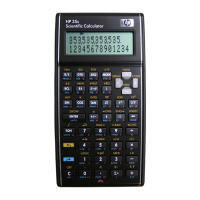Getting Started 11
number that was in the X–register before the last numeric func-
tion was executed. Pressing ºÍ returns this value into the
X–register. Retrieving the "last x" has two primary uses, correct-
ing errors and reusing a number in a calculation. For example,
suppose you wanted to find the square root of a number, but
pressed T by mistake. You don't have to start over! To find
the correct result, press ºÍ?.
Some numerical operations require a single number for input,
such as º&, and k. In RPN mode, enter the number first
and then the operation to be applied. For example, to square 3,
press 3º=.
Some operations require two numbers, such as Ù,) and
¹x. The Ï key is used to separate two numbers keyed
in one after the other. For example, suppose the stack is already
filled with 1, 2, 3, and 4 and you wish to evaluate 5+6. Press
5Ï6Ù. When 5 is pressed, the contents of the stack
are pushed up one level – the previous value of 1 in the T regis-
ter is lost. Pressing Ï copies the X register to the Y register,
pushing up the stack contents again but disabling stack lift. This
stack lift disable condition after pressing Ï allows the 6
keyed in next to overwrite the copy of 5 in the X register without
pushing the stack up. The Ù adds the X and Y register contents
together and drops the other stack values down one level.
Therefore, the value of 3 in T is copied down to Z as shown

